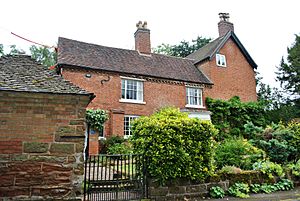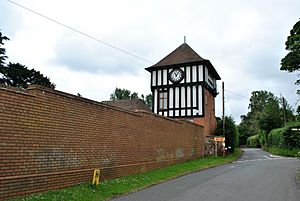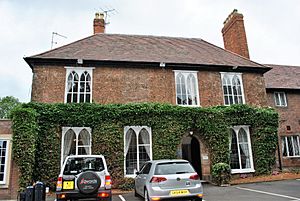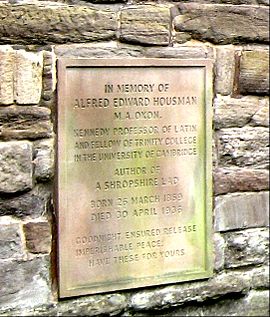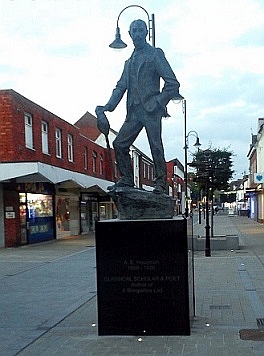A. E. Housman facts for kids
Quick facts for kids
A. E. Housman
|
|
|---|---|

Photo portrait by E. O. Hoppé, 1910
|
|
| Born | Alfred Edward Housman 26 March 1859 Bromsgrove, Worcestershire, England |
| Died | 30 April 1936 (aged 77) Cambridge, England |
| Pen name | A. E. Housman |
| Occupation | Classicist and poet |
| Alma mater | St John's College, Oxford |
| Genre | Lyric poetry |
| Notable works | A Shropshire Lad |
| Relatives | Clemence Housman, Laurence Housman |
| Signature | |
Alfred Edward Housman (born March 26, 1859 – died April 30, 1936) was an English expert in ancient languages and a famous poet. He had a tough start at university. But he later became a respected scholar by publishing his own research.
Housman then became a professor of Latin at University College London. He later taught at the University of Cambridge. Today, he is known as one of the most important classical scholars of his time. His works on ancient writers like Juvenal, Manilius, and Lucan are still highly valued.
In 1896, he became known as a poet with his book A Shropshire Lad. This collection of poems featured a simple, thoughtful young person. After a slow start, the book became very popular with young readers. Its focus on early death especially resonated during times of war. In 1922, his Last Poems further boosted his fame. Many of his poems were also turned into songs. After he died, his brother, Laurence, published more poems from his notebooks.
Contents
Early Life and Education
Alfred Edward Housman was the oldest of seven children. He was born at Valley House in Fockbury, near Bromsgrove, England. His mother passed away on his twelfth birthday. His father, a country lawyer, remarried in 1873. Two of Housman's siblings also became well-known writers: his sister Clemence Housman and brother Laurence Housman.
Housman went to King Edward's School and Bromsgrove School. He showed great academic talent and won awards for his poems. In 1877, he earned a scholarship to St John's College, Oxford. There, he studied classics, which means ancient Greek and Roman studies.
Even though he was a quiet person, Housman made close friends with his roommates, Moses John Jackson and A. W. Pollard. Housman did very well in his early exams. However, he focused so much on studying ancient texts that he didn't pay enough attention to ancient history and philosophy. Because of this, he failed his final exams. He had to return to Oxford to retake the exam and get a basic pass degree. Many people believe his poor performance was due to being distracted by his father's serious illness. He was also very confident in his skills and spent a lot of time with friends.
After Oxford, Housman got a job as a clerk in the Patent Office in London. He continued his classical studies on his own time. He published many scholarly articles about ancient writers like Horace and Ovid. He became so well-known for his knowledge that in 1892, he was offered a Latin professorship at University College London (UCL).
Later Life and Career
Housman first worked on both Latin and Greek studies. But he later decided to focus only on Latin poetry. He explained that he couldn't be excellent at both. In 1911, he became the Kennedy Professor of Latin at Trinity College, Cambridge. He stayed there for the rest of his life.
Between 1903 and 1930, Housman published a major critical edition of Manilius's Astronomicon. He also edited works by Juvenal (1905) and Lucan (1926). Other experts praised his work highly. They said his scholarship was incredibly valuable and that he was a brilliant textual critic.
Housman was known for being very strict about good scholarship. He sometimes criticized other scholars harshly if he thought their work was sloppy. He believed that a good scholar needed a sharp mind, not just knowledge.
His colleague, A. S. F. Gow, noted that Housman could be intimidating to students. He was very serious about his academic work. In his private life, Housman enjoyed walking in the countryside, good food, and traveling to France. He saw his poetry as less important than his scholarly work. He didn't speak publicly about his poems until 1933. In a lecture then, he said that poetry should touch emotions, not just the mind.
Housman passed away at age 77 in Cambridge. His ashes are buried near St Laurence's Church, Ludlow. A cherry tree was planted there in his memory.
Poetry Collections
A Shropshire Lad
During his time in London, Housman finished A Shropshire Lad. This collection has 63 poems. After one publisher turned it down, he helped pay for its publication in 1896. It sold slowly at first but then became a huge success. English musicians setting his poems to music helped make it widely known. Before World War I, its themes deeply connected with English readers. The book has been printed continuously since May 1896.
The poems often talk about sadness and death. Housman wrote many of them while living in Highgate, London. He had not even visited Shropshire yet. He imagined Shropshire as a perfect, peaceful countryside. Housman said he was influenced by ancient Greek and Latin writers. He also mentioned Shakespeare's songs, Scottish ballads, and Heine as inspirations.
Later Poems
Housman started gathering new poems after World War I. His early work influenced many British poets who wrote about the war. He also wrote some poems to honor those who died in the war. This included his Epitaph on an Army of Mercenaries. This poem honored the British Expeditionary Force, a small group of professional soldiers sent to Belgium.
In the early 1920s, Housman wanted his friend Moses Jackson to read his best unpublished poems before Jackson died. These later poems were mostly written before 1910. They show more variety than those in A Shropshire Lad. He published this new collection as Last Poems (1922). He felt he had no more inspiration left and decided not to publish more during his lifetime.
After Housman's death in 1936, his brother, Laurence, published more poems. These appeared in More Poems (1936) and Collected Poems (1939). Laurence also published A. E. H.: Some Poems, Some Letters and a Personal Memoir by his Brother (1937). This book included funny poems, like a parody of Longfellow's poem Excelsior. Housman also wrote a funny Fragment of a Greek Tragedy, which was published after he died.
John Sparrow shared a letter from Housman. In it, Housman described how his poems came to him. He said some lines would just appear in his mind. Then he would work on them, sometimes for months, to finish the poem.
Musical Settings of Housman's Poetry
Many British composers turned Housman's poetry into music. This was especially true for A Shropshire Lad in the early 20th century. The themes of nature and tradition in his poems fit well with English music of that time.
In 1904, Arthur Somervell set the entire A Shropshire Lad cycle to music. This helped other composers discover Housman's work. Ralph Vaughan Williams created his well-known song cycle, On Wenlock Edge, in 1909. It was for a singer, string quartet, and piano. Between 1909 and 1911, George Butterworth also created two collections of songs from A Shropshire Lad. He also wrote an orchestral piece called A Shropshire Lad.
Ivor Gurney was another composer who set Housman's poems to music. He worked on his cycle Ludlow and Teme during World War I. He later composed The Western Playland. John Ireland also created a song cycle called The Land of Lost Content. Charles Wilfred Orr set more of Housman's poems to music than any other composer. Even composers not usually known for pastoral music, like Arnold Bax, were drawn to Housman's poetry.
By 1976, there were over 400 musical settings of Housman's poems. As of 2023, there are 646 settings of 188 different poems.
Commemorations and Legacy
The first memorial for Housman was in the chapel of Trinity College in Cambridge. There is a brass plaque there. The Latin words on it were written by his colleague, A. S. F. Gow.
From 1947, a common room at University College London was named the Housman Room in his memory. Later, blue plaques were placed on buildings where he lived or worked. One was on Byron Cottage in Highgate in 1969, marking where A Shropshire Lad was written. More plaques followed in Bromsgrove, his hometown. These were supported by the Housman Society, founded in 1973. A statue of Housman walking with a stick was also put up in Bromsgrove High Street in 1985.
In 1996, on the 100th anniversary of A Shropshire Lad, more blue plaques were set up. A memorial window was also dedicated at Poets' Corner in Westminster Abbey. The next year, Tom Stoppard's play The Invention of Love premiered.
As the 150th anniversary of his birth approached, London University started its Housman lectures on classical subjects in 2005. In 2009, a new edition of A Shropshire Lad was published with photos of Shropshire. There were also performances of musical works based on his poems in Ludlow.
Works
Poetry collections
- A Shropshire Lad (1896)
- Last Poems (1922, Henry Holt & Company)
- A Shropshire Lad: Authorized Edition (1924, Henry Holt & Company)
- More Poems (1936, Barclays)
- Collected Poems (1940, Henry Holt & Company)
- Collected Poems (1939); the poems included in this volume but not the three above are known as Additional Poems. The Penguin edition of 1956 includes an introduction by John Sparrow.
- Manuscript Poems: Eight Hundred Lines of Hitherto Uncollected Verse from the Author's Notebooks, ed. Tom Burns Haber (1955)
- Unkind to Unicorns: Selected Comic Verse, ed. J. Roy Birch (1995; 2nd ed. 1999)
- The Poems of A. E. Housman, ed. Archie Burnett (1997)
- A Shropshire Lad and Other Poems (2010, Penguin Classics)
Classical scholarship
- P. Ovidi Nasonis Ibis (1894. In J. P. Postgate's "Corpus Poetarum Latinorum")
- M. Manilii Astronomica (1903–1930; 2nd ed. 1937; 5 vols.)
- D. Iunii Iuuenalis Saturae: editorum in usum edidit (1905; 2nd ed. 1931)
- M. Annaei Lucani, Belli Ciuilis Libri Decem: editorum in usum edidit (1926; 2nd ed. 1927)
- The Classical Papers of A. E. Housman, ed. J. Diggle and F. R. D. Goodyear (1972; 3 vols.)
- "Housman's Latin Inscriptions", William White, The Classical Journal (1955) 159–166
Published lectures
These lectures are listed by date of delivery, with date of first publication given separately if different.
- Introductory Lecture (1892)
- "Swinburne" (1910; published 1969)
- Cambridge Inaugural Lecture (1911; published 1969 as "The Confines of Criticism")
- "The Application of Thought to Textual Criticism" (1921; published 1922)
- "The Name and Nature of Poetry" (1933)
Prose collections
Selected Prose, edited by John Carter, Cambridge University Press, 1961
Collected letters
- The Letters of A. E. Housman, ed. Henry Maas (1971)
- The Letters of A. E. Housman, ed. Archie Burnett (2007)
See Also
 In Spanish: A. E. Housman para niños
In Spanish: A. E. Housman para niños
- The Invention of Love
Images for kids


